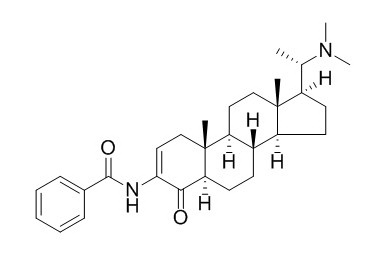Axillaridine A
Axillaridine A is a new cholinesterase inhibitors, it may act as potential leads in the discovery of clinically useful inhibitors for nervous-system disorders, particularly by reducing memory deficiency in Alzheimer’s disease patients by potentiating and effecting the cholinergic transmission process. (+)-Axillaridine A has significant activity as antiestrogen binding site (AEBS)-inhibitory agents.
Inquire / Order:
manager@chemfaces.com
Technical Inquiries:
service@chemfaces.com
Tel:
+86-27-84237783
Fax:
+86-27-84254680
Address:
1 Building, No. 83, CheCheng Rd., Wuhan Economic and Technological Development Zone, Wuhan, Hubei 430056, PRC
Providing storage is as stated on the product vial and the vial is kept tightly sealed, the product can be stored for up to
24 months(2-8C).
Wherever possible, you should prepare and use solutions on the same day. However, if you need to make up stock solutions in advance, we recommend that you store the solution as aliquots in tightly sealed vials at -20C. Generally, these will be useable for up to two weeks. Before use, and prior to opening the vial we recommend that you allow your product to equilibrate to room temperature for at least 1 hour.
Need more advice on solubility, usage and handling? Please email to: service@chemfaces.com
The packaging of the product may have turned upside down during transportation, resulting in the natural compounds adhering to the neck or cap of the vial. take the vial out of its packaging and gently shake to let the compounds fall to the bottom of the vial. for liquid products, centrifuge at 200-500 RPM to gather the liquid at the bottom of the vial. try to avoid loss or contamination during handling.
Neuroscience.2024, 559:77-90.
BMC Plant Biol.2022, 22(1):128.
Korean J. Food Preserv.2023, 30(4):663-668.
J Nat Med.2018, 72(3):734-744
Molecules.2021, 26(9):2765.
Planta Med.2023, a-2192-2281.
J Clin Med.2019, 8(10):E1664
Regen Biomater.2023, 10:rbad077.
Oncol Rep.2021, 46(1):143.
J AOAC Int.2024, qsae028.
Related and Featured Products
J Nat Prod. 1998 Oct;61(10):1257-62.
Activity-guided isolation of steroidal alkaloid antiestrogen-binding site inhibitors from Pachysandra procumbens.[Pubmed:
9784163]
METHODS AND RESULTS:
Four novel steroidal alkaloids, (+)-(20S)-20-(dimethylamino)-3-(3'alpha-isopropyl)-lactam-5alpha-+ ++preg n-2-en-4-one (1), (+)-(20S)-20-(dimethylamino)-16alpha-hydroxy-3-(3'alpha-isopropyl) -la ctam-5alpha-pregn-2-en-4-one (2), (+)-(20S)-3-(benzoylamino)-20-(dimethylamino)-5alpha-pregn-2-en-++ +4beta -yl acetate (3), and (+)-(20S)-2alpha-hydroxy-20-(dimethylamino)-3beta-phthalimido-5 alpha- pregnan-4beta-yl acetate (4), as well as five known compounds, (-)-pachyaximine A (5), (+)-spiropachysine (6), (+)-Axillaridine A (7), (+)-epipachysamine D (8), and (+)-pachysamine B (9), were isolated from Pachysandra procumbens, using a bioassay-guided fractionation based on inhibition of 3H-tamoxifen binding at the antiestrogen binding site (AEBS).
CONCLUSIONS:
Compounds 1-7 and 9 demonstrated significant activity as AEBS-inhibitory agents, and compounds 3, 5 and 9 were found to potentiate significantly the antiestrogenic effect mediated by tamoxifen in cultured Ishikawa cells. The structure elucidation of compounds 1-4 was carried out by spectral data interpretation.
Helv. Chim. Acta, 2002, 85(2):678-88.
Pregnane-Type Steroidal Alkaloids of Sarcococca saligna: A New Class of Cholinesterase Inhibitors[Reference:
WebLink]
METHODS AND RESULTS:
The structures of the new alkaloids salignenamide C (1), salignenamide D (2), 2b-hydroxyepipachysamine D (3), salignenamide E (4), and salignenamide F (5) were elucidated with the help of modern spectroscopic techniques, while the known alkaloids axillarine C (6), axillarine F (7), sarcorine (8), N 3 -demethylsaracodine (9), saligcinnamide (10), salignenamide A (11), vaganine A (12), Axillaridine A (13), sarsalignone (14), and sarsalignenone (15) were identified by comparing their spectral data with those reported earlier. Inhibition of electric-eel acetylcholinesterase (EC 3.1.1.7) and horse-serum butyrylcholinesterase (EC 3.1.1.8) by alkaloids 1 ± 15 were investigated.
CONCLUSIONS:
These new cholinesterase inhibitors may act as potential leads in the discovery of clinically useful inhibitors for nervous-system disorders, particularly by reducing memory deficiency in Alzheimer×s disease patients by potentiating and effecting the cholinergic transmission process.
J Enzyme Inhib Med Chem. 2009 Oct;24(5):1101-5.
Molecular dynamics simulation of Axillaridine-A: a potent natural cholinesterase inhibitor.[Pubmed:
19555175]
Molecular Dynamics (MD) simulations were carried out for human acetylcholinesterase (hAChE) and its complex with Axillaridine A, in order to dynamically explore the active site of the protein and the behaviour of the ligand at the peripheral binding site.
METHODS AND RESULTS:
Simulation of the enzyme alone showed that the active site of AChE is located at the bottom of a deep and narrow cavity whose surface is lined with rings of aromatic residues while Tyr72 is almost perpendicular to the Trp286, which is responsible for stable pi -pi interactions. The complexation of AChE with Axillaridine A, results in the reduction of gorge size due to interaction between the ligand and the active site residues. The gorge size was determined by the distance between the center of mass of Glu81 and Trp286. As far as the geometry of the active site is concerned, the presence of ligand in the active site alters its specific conformation, as revealed by stable hydrogen bondings established between amino acids. With the increasing interaction between ligand and the active amino acids, size of the active site of the complex decreases with respect to time.
CONCLUSIONS:
Axillaridine A, forms stable pi -pi interactions with the aromatic ring of Tyr124 that results in inhibition of catalytic activity of the enzyme.
This pi -pi interaction keeps the substrate stable at the edge of the catalytic gorge by inhibiting its catalytic activity. The MD results clearly provide an explanation for the binding pattern of bulky steroidal alkaloids at the active site of AChE.



